This article was published in Scientific American’s former blog network and reflects the views of the author, not necessarily those of Scientific American
There aren't many times when you can be in medias res and at the beginning simultaneously, but this is one. It's the middle of the Quartzville field trip; it's where the story of Quartzville's modest mineral wealth begins. A place like this should have a name of suitable grandeur. Visually, it's rather stunning.
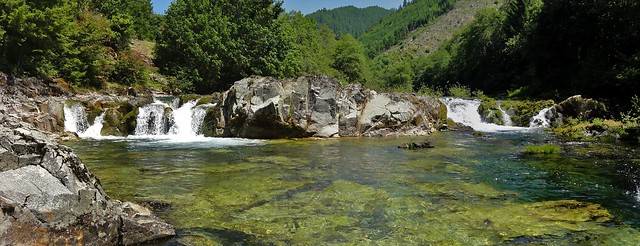
Yellowbottom Falls. Credit: Dana Hunter
So why the tarnation did people name it Yellowbottom?
On supporting science journalism
If you're enjoying this article, consider supporting our award-winning journalism by subscribing. By purchasing a subscription you are helping to ensure the future of impactful stories about the discoveries and ideas shaping our world today.
Well, there's the gold in the gravels and silt at the bottom of pools. It's enough for a desultory bit of placer mining today, and that bit of gold kept some folks whole during the Great Depression. And gold's sort of yellow, so yeah. Yellowbottom. Fair enough.
The geology's a bit more interesting than the mere fact that gold-speckled gravels are being swept down river and deposited here. So let's have a look at the place. Here's a map, for those who like to get oriented. You can also see a rather more precise location at Flickr.
As you drive up Quartzville Drive, following the Middle Santiam River, you'll see progressively more hydrothermically altered rocks. Some of them are recognizably basalt or andesite, some rhyolite; some are so altered you can't tell what they used to be. Then you come to this place, just in time for lunch, and the first thing you notice is that you're not among extrusives anymore. Instead of cooked volcanic materials that erupted onto the surface, you're standing on something that manifestly cooled underground.
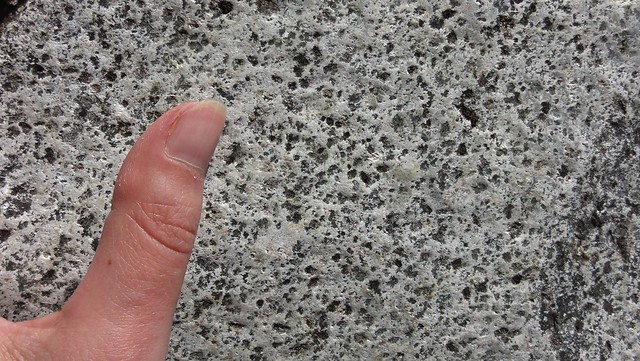
Weathered diorite at Yellowbottom Falls. Credit: Dana Hunter
This is a coarse-grained volcanic rock. Mind you, the river's plucked a lot of the grains out on this sample, but many are still there within. Knowing the basics of how molten rocks cool and crystallize, you can tell at a glance that this stuff cooled slowly underground. If you know your minerals, you'll be able to identify most of the dark ones as hornblende, and the lighter ones as plagioclase feldspar. This is diorite, which erupts as andesite. This stuff didn't get that far: it stayed beneath the surface, cooling gradually, although we can't quite say chillin'. It takes a very long time for an insulated magma body to cool to crustal temperature.
This diorite is massive, and it's very, very hard. It has vigorously resisted the power of the river to wear it down. Lockwood thinks the falls were created by a fault - the region's littered with them, great and small, and a fault fits the picture. I'm not sure when the last movement would have been, but it's been a while, judging from the wear and tear on these rocks. Yet they're still pretty rugged.
Did I mention this stuff is hard? The Code of Hammurabi, inscribed on a dark diorite pillar, has survived for nearly two thousand years. Prior to the advent of modern materials, road builders found it an excellent material for paving. And, if Wikipedia is to be believed, it was valued highly enough "that the first great Mesopotamian empire—the Empire of Sargon of Akkad -- listed the taking of diorite as a purpose of military expeditions." One assumes they let some other poor buggers cut it into manageable blocks before they went to war over it.
Diorite tells some interesting stories, not all of them having to do with marauding Akkadians. It's best tale is a geologic one. When you see diorite, you know there's been a subduction zone nearby. This is a rock of volcanic arcs and cordilleran mountain building, where mafic rock has partially melted, and the result of that partial melt has moseyed up toward the surface. Sometimes, it erupts as andesite. Sometimes, it cools in place, forming plutons and batholiths and stocks. But it isn't born on placid plate margins. So even if the landscape is currently calm, diorite tells you things used to be very exciting indeed.
So, even if we didn't know we're in the Western Cascades, which were the old volcanic arc above the descending slab of the Juan de Fuca plate before its descent slowed and shallowed and caused the arc to migrate eastward, we'd still know we're in subduction territory. And even if we hadn't yet seen the active volcanoes in the region, we'd know from this diorite's young age age – 18 million years or thereabouts – that the subduction zone is still nearby.
Blobs of this stuff are found in quite a few places in the Quartzville district. The Oregon geologic map I've linked lists their ages as 8 to 22 million years. And while they intruded, they sent heated fluids circulating through the existing rocks. Hydrothermal fluids cooked the system, deposited all sorts of minerals, including the copious amounts of quartz that gave Quartzville its name, and left the gold that gave the town its brief raison d'être.
But it's not just flakes of gold and a healthy amount of diorite you'll find at this spot. Look at this photo, and notice the rather large chunk missing.
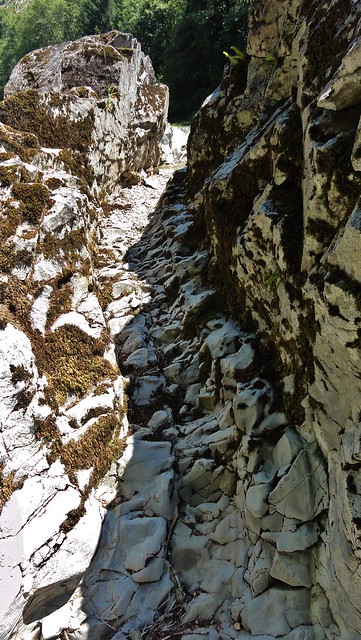
Eroded dike at Yellowbottom Falls. Credit: Dana Hunter
Can you guess why there's a great gouge there? Here's a hint:
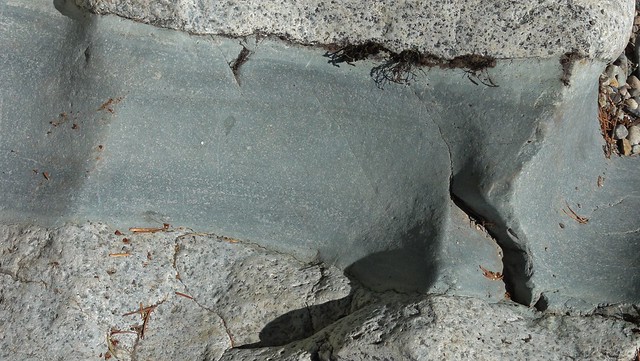
Credit: Dana Hunter
Looks a bit like a maniacal home improvement addict went through caulking cracks, doesn't it? And what a lovely, restful, blue-gray-green color they chose! Quite a few cracks in the diorite are filled with this stuff, but it ain't from the Home Depot.
Figured it out? Yup, that's basalt, which intruded some time after the diorite cooled. It found cracks and joints and wedged itself right in. But while it's younger, the basalt is far, far softer, and the river has smoothed and carved and eroded it right out, leaving the diorite standing alone in many places.
The whole place is riddled with basalt dikes. They invaded every available orifice, and where the river hasn't finished removing them, they're quite lovely. Here's a quite nice one sparkling under the river bed.
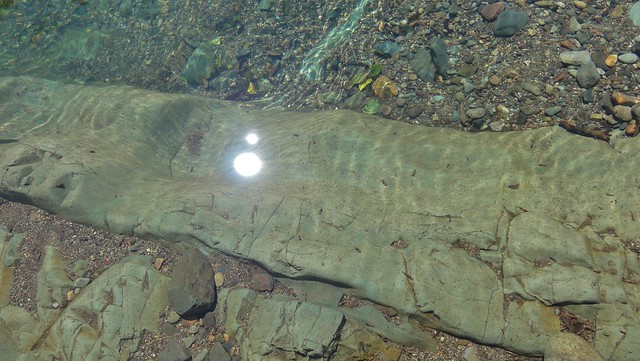
Basalt dike underwater at Yellowbottom Falls. Credit: Dana Hunter
This dike aiming at the falls shows quite nicely just how soft the basalt is in comparison to the diorite: notice how it's been partially scoured out, while the diorite remains.

Partially eroded basalt dike, diorite, and waterfall. Credit: Dana Hunter
So there you are: the center of it all, the place that created the hydrothermal system that deposited all the pretty shiny things. It's geologically important and aesthetically pleasing. If you feel like panning the gravels in those cold pools beneath the falls, you might even end up with a little bit of that yellow bottom. It's a great spot, a perfect place to consume lunch and contemplate the awesome power of plate tectonics.